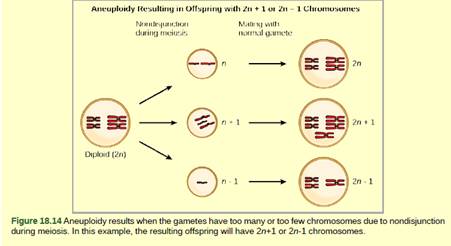
Concept explainers
Figure 18.14 Which is most likely to survive, offspring with 2n+l chromosomes or offspring with 2n-l chromosomes?

To analyze:
The survival ability of an offspring with 2n+1 chromosomes or an offspring with 2n-1 chromosomes.
Introduction:
The accuracy of cell division is very important in the production and the survival of the normal offspring. Any error in the cell division can lead to the presence of an abnormal number of chromosomes in a cell. One such condition in which, a cell is missing one chromosome or showing an extra chromosome is called aneuploidy.
Explanation of Solution
Aneuploidy is observed when chromosomes undergo non-disjunction or do not separate properly between the two diving cells at the time of cell division. Two types of aneuploidy are the monosomy and the trisomy. Monosomy refers to lack of one chromosome of the normal chromosomal complement resulting in 2n-1 condition.
Trisomy refers to the presence of three copies of a particular chromosome resulting in 2n+1 condition. Monosomy is said to be harmful as the missing chromosome causes an imbalance in the genome or the genes are lost from the chromosome set. In most of the cases, such embryos with 45 chromosomes instead of 46 will die. Whereas, the presence of trisomy is less lethal as the genetic material is not lost and the embryos remain viable.
Thus, loss of genetic material is always lethal to any organism and therefore, an organism with 2n+1 chromosome is more likely to survive.
Want to see more full solutions like this?
Chapter 18 Solutions
BIOLOGY
Additional Science Textbook Solutions
College Physics
Campbell Essential Biology with Physiology (5th Edition)
Human Physiology: An Integrated Approach (8th Edition)
Campbell Essential Biology with Physiology (6th Edition)
Microbiology with Diseases by Body System (4th Edition)
Biology: Life on Earth with Physiology (11th Edition)
- The mating below shows the sex chromosome found in two parents and their resulting offspring. Use this family information to answer the following questions. Xfmr1 Y x Xfmr1 XFMR1 → XFMR1 XFMR1Y How many Barr bodies would the child have? a. 3 b. 2 c. 1 d. 0 e. Cannot be determinedarrow_forwardWhat is the probability that the parents below will produce the indicated offspring? (Assume all genes are on different chromosomes.) without punnet square AaBBDdggHhNn x AAbbDdGgHhNn produce AABbddGgHhNN offspringarrow_forwardIn the following diagram, designate each daughter cell as diploid (2n) or haploid (n).arrow_forward
- Which of the following statements is not true in comparing mitosis and meiosis? a. Twice the number of cells are produced in meiosis as in mitosis. b. Meiosis is involved in the production of gametes, unlike mitosis. c. Crossing over occurs in meiosis I but not in meiosis II or mitosis. d. Meiosis and mitosis both produce cells that are genetically identical. e. In both mitosis and meiosis, the parental cell is diploid.arrow_forwardFigure 13.6 Which of the following statements about nondisjunction is true? Nondisjunction only results in gametes with n+1 or n-1 chromosomes. Nondisjunction occurring during meiosis II results in 50 percent normal gametes. Nondisjunction during meiosis I results in 50 percent normal gametes. Nondisjunction always results in four different kinds of gametes.arrow_forwardFigure 8.10 In pea plants, purple flowers (P) are dominant to white (p), and yellow peas (Y) are dominant to green (y). What are the possible genotypes and phenotypes for a cross between PpYY and ppYy pea plants? How many squares would you need to complete a Punnett square analysis of this cross?arrow_forward
- Figure 8.9 In pea plants, round peas (R) are dominant to wrinkled peas (r). You do a test cross between a pea plant with wrinkled peas (genotype rr) and a plant of unknown genotype that has round peas. You end up with three plants, all which have round peas. From this data, can you tell if the parent plant is homozygous dominant or heterozygous?arrow_forwardGo back to Problem 1, and assume you now study a third gene having alleles C and c. For each genotype listed, what type(s) of gametes can be produced? a. AABBCC b. AaBBcc c. AaBBCc d. AaBbCcarrow_forwardIn organisms with the ZZ-ZW sex-determining system, from which of the following possibilities can a female inherit her Z chromosome? Yes No Her mother’s mother ____________ ____________ Her mother’s father ____________ ____________ Her father’s mother ____________ ____________ Her father’s father ____________ ____________arrow_forward
- Choose which of the following is true: a) Haploid cells have one allele per gene b) Haploid cells have two alleles per genearrow_forwardWhich of the four daughter cells shown at right would produce an offspring with trisomy 3 after it is fertilized? A.) A B.) B C.) C D.) Darrow_forwardThe answer to Question 23 will be different if R and T are very far apart on their chromosome (and if that is true, then automatically r and t will also be very far apart on their chromosome). If it undergoes meiosis, there are four genotypes that can be produced, not just two. Why? What are the four genotypes? Which represent recombinant chromosomes? Which represent parental chromosomes? Look at Figure 16-18 for help if you need it.arrow_forward
 Biology 2eBiologyISBN:9781947172517Author:Matthew Douglas, Jung Choi, Mary Ann ClarkPublisher:OpenStax
Biology 2eBiologyISBN:9781947172517Author:Matthew Douglas, Jung Choi, Mary Ann ClarkPublisher:OpenStax Human Biology (MindTap Course List)BiologyISBN:9781305112100Author:Cecie Starr, Beverly McMillanPublisher:Cengage Learning
Human Biology (MindTap Course List)BiologyISBN:9781305112100Author:Cecie Starr, Beverly McMillanPublisher:Cengage Learning Concepts of BiologyBiologyISBN:9781938168116Author:Samantha Fowler, Rebecca Roush, James WisePublisher:OpenStax College
Concepts of BiologyBiologyISBN:9781938168116Author:Samantha Fowler, Rebecca Roush, James WisePublisher:OpenStax College Human Heredity: Principles and Issues (MindTap Co...BiologyISBN:9781305251052Author:Michael CummingsPublisher:Cengage Learning
Human Heredity: Principles and Issues (MindTap Co...BiologyISBN:9781305251052Author:Michael CummingsPublisher:Cengage Learning



